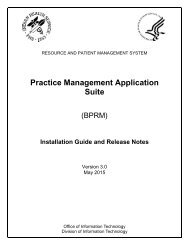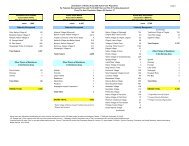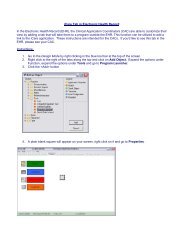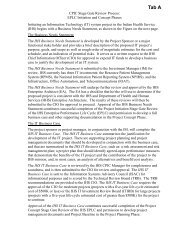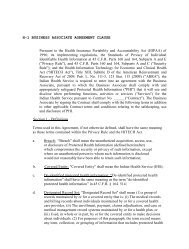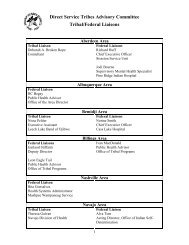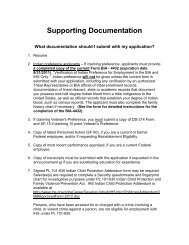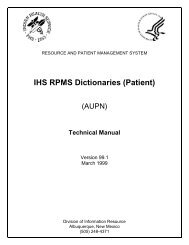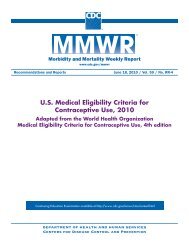What's New in Diabetic Neuropathy?
What's New in Diabetic Neuropathy?
What's New in Diabetic Neuropathy?
You also want an ePaper? Increase the reach of your titles
YUMPU automatically turns print PDFs into web optimized ePapers that Google loves.
What’s <strong>New</strong> <strong>in</strong> <strong>Diabetic</strong><br />
<strong>Neuropathy</strong>?<br />
Jill Kimm, MD<br />
Jill.kimm@kdmc.net 606-694-0031<br />
Ashland, Kentucky<br />
August, 2011
WWW.IHS.GOV<br />
• MEDICAL PROGRAMS<br />
• DIVISION OF DIABETES AND PREVENTION<br />
• DM2 DIABETES AND NEUROPATHY<br />
• Quick Guide Cards<br />
• DM Treatment Algorithms<br />
• DIABETES CARE 2011; 34 (supplement 1)<br />
• NEUROLOGY prepublished onl<strong>in</strong>e April 11, 2011<br />
• JAMA 2009; 302(13): 1451-1458.<br />
Presented by IHS Division of Diabetes<br />
2
*<br />
Presented by IHS Division of Diabetes<br />
3
Case Presentation<br />
• 60 year old R handed NA man with a ten year history of<br />
DM II. His A1c falls between 9 and 10. He adheres to<br />
medication regimes but has trouble stick<strong>in</strong>g to diet and<br />
exercise recommendations. He has never mentioned nerve<br />
pa<strong>in</strong> or numbness until you ask him at his annual visit.<br />
• About 5 years ago he began to note stabb<strong>in</strong>g pa<strong>in</strong>s <strong>in</strong> all<br />
toes. He noted some woody numbness of both feet and<br />
imbalance on uneven surfaces. Numbness has migrated to<br />
mid-sh<strong>in</strong>s. The pa<strong>in</strong> has progressed and become<br />
bothersome. He feels like he is walk<strong>in</strong>g on broken glass.<br />
His feet burn at night, and the touch of the sheets feels<br />
pa<strong>in</strong>ful. He th<strong>in</strong>ks he has bad circulation.<br />
Presented by IHS Division of Diabetes<br />
4
Case Presentation<br />
• PMH: HTN, hyperlipidemia<br />
• PSH: bunionectomy<br />
• P+SH: no drugs, EtOH<br />
• FMH: DM<br />
• Meds: lis<strong>in</strong>opril, metform<strong>in</strong>, Lantus<br />
• ROS: He admits dizz<strong>in</strong>ess, erectile dysfunction,<br />
constipation, nocturnal diarrhea, weight ga<strong>in</strong><br />
Presented by IHS Division of Diabetes<br />
5
Case Presentation: Exam<br />
• BP ly<strong>in</strong>g 120/80 sitt<strong>in</strong>g 110/80 stand<strong>in</strong>g 80/64.<br />
• P 100 R 12 T 98.4 W 295 lb.<br />
• Heart, lungs, neck, normal. Extremities hairless with dry,<br />
callused sk<strong>in</strong> of feet, pulses <strong>in</strong>tact.<br />
• MS – normal.<br />
• CN II-XII - normal aside from miotic pupils.<br />
• Motor – 4+/5 dorsiflexion of great toe .<br />
• Sense – decreased PP and cold sensation to knees. Absent<br />
vibration perception to mid-sh<strong>in</strong>.<br />
• CBM – tandem poor, casual normal, cannot walk on heels .<br />
• DTRs – BRJ 1/1 BJ 1/1 TJ 1/1 KJ tr/tr AJ 0/0.<br />
Presented by IHS Division of Diabetes<br />
6
Th<strong>in</strong>k<strong>in</strong>g<br />
• Classic presentation for chronic, long stand<strong>in</strong>g<br />
diabetic neuropathy with sensorimotor <strong>in</strong>volvement,<br />
one of the microvascular complications.<br />
• People associate numbness, but not pa<strong>in</strong>, with<br />
neuropathy, th<strong>in</strong>k “bad circulation.” This is chronic<br />
already.<br />
• He likely has autonomic neuropathy.<br />
Presented by IHS Division of Diabetes<br />
7
ADA Def<strong>in</strong>ition, Recommendations<br />
• Symmetrical, length-dependent sensorimotor<br />
polyneuropathy attributable to metabolic and<br />
microvessel alterations as a result of chronic<br />
hyperglycemia exposure and cardiovascular risk<br />
covariates. -Diabetes Care 33: 2285-2293, 2010<br />
• Screen at diagnosis and yearly for DPN us<strong>in</strong>g simple<br />
tests. EP studies are rarely necessary.<br />
• Screen for autonomic neuropathy.<br />
• Medications improve quality of life.<br />
- Diabetes Care 34 (supplement 1): S8, 2011.<br />
Presented by IHS Division of Diabetes<br />
8
<strong>Diabetic</strong> Neuropathies<br />
Focal/Multifocal Polyneuropathy<br />
• Mononeuropathy<br />
• Median<br />
• Ulnar >>> Radial<br />
• Multiple lesions “mononeuritis<br />
multiplex” RARE<br />
• Amyotrophy, proximal motor<br />
neuropathy<br />
• Deep, burn<strong>in</strong>g thigh pa<strong>in</strong><br />
• Progressive, asymmetric<br />
proximal weakness<br />
• Marked quadriceps wast<strong>in</strong>g &<br />
absent knee jerk(s)<br />
Presented by IHS Division of Diabetes<br />
• <strong>Diabetic</strong> peripheral neuropathy,<br />
polyneuropathy, sensorimotor<br />
neuropathy<br />
• Acute sensory neuropathy<br />
• Very poor control or DKA, rapid<br />
glycemic control, or weight loss<br />
• Small fiber, normal exam<br />
• Resolves <strong>in</strong> a year<br />
• Autonomic neuropathy<br />
• Orthostatic hypotension<br />
• Gastroparesis, constipation,<br />
nocturnal diarrhea<br />
• Bladder hypomotility<br />
• Sexual dysfunction<br />
• Sudomotor and pupil abnormalities<br />
9
<strong>Diabetic</strong> <strong>Neuropathy</strong><br />
• Most common (90%) is DSMPN, DPN<br />
• Symmetric, length-dependent <strong>in</strong>jury to peripheral<br />
nerves<br />
• Axonal<br />
• 16% -60% of diabetics; half have pa<strong>in</strong><br />
• Frequently untreated (40%)<br />
• A microvascular complication, like kidney and ret<strong>in</strong>a<br />
• Pivotal component of foot disease and morbidity<br />
Presented by IHS Division of Diabetes<br />
10
Classic Symptoms<br />
• Pa<strong>in</strong> worsens at night and improves with walk<strong>in</strong>g<br />
• Ach<strong>in</strong>g, lanc<strong>in</strong>ation, burn<strong>in</strong>g<br />
• Location 96% feet, 69% balls of feet, 67% toes, 54%<br />
dorsal feet, 37% plantar feet, 39% hands, 37% calves,<br />
32% heels<br />
• Allodynia<br />
• Hyperalgesia, hyperpathia<br />
• Numbness<br />
• Paresthesia, dysesthesia<br />
Presented by IHS Division of Diabetes<br />
11
Red Flags – Wrong Diagnosis<br />
• Pronounced asymmetry<br />
• Predom<strong>in</strong>ant motor deficits, one nerve or one root,<br />
cranial neuropathy<br />
• Pa<strong>in</strong> with walk<strong>in</strong>g relieved by rest<br />
• Rapid progression despite ideal control<br />
• Symptoms and deficits <strong>in</strong> arms only<br />
• Family history non-diabetic neuropathy<br />
• Cannot confirm diagnosis by exam (good reflexes and<br />
vibration perception, e.g.)<br />
• Labs: TSH, B12, SPIEP, RPR<br />
Presented by IHS Division of Diabetes<br />
12
Patient Education<br />
• A condition that can develop <strong>in</strong> diabetics.<br />
• High blood sugar can cause nerve damage <strong>in</strong> feet and legs. The<br />
damage slows down nerve signals to the muscles and sk<strong>in</strong>. It can<br />
cause the nerves to send wrong signals at wrong times, which<br />
can cause pa<strong>in</strong>. Sometimes the nerves can stop communicat<strong>in</strong>g<br />
completely, and that can lead to numbness and weakness.<br />
• People with neuropathy have many symptoms. Some people<br />
already have nerve symptoms when DM is diagnosed. Symptoms<br />
tend to develop slowly over years.<br />
• The nerves and organs that control automatic body processes<br />
may be hurt by diabetes. Some people develop dizz<strong>in</strong>ess on<br />
stand<strong>in</strong>g. Sweat<strong>in</strong>g may <strong>in</strong>crease or decrease. Upset stomach,<br />
constipation, and nighttime diarrhea may occur. Bladder control<br />
and sexual function may be bothered. This is called autonomic<br />
neuropathy.<br />
Presented by IHS Division of Diabetes<br />
13
<strong>Diabetic</strong> <strong>Neuropathy</strong> Symptom Score<br />
• Are you experienc<strong>in</strong>g unstead<strong>in</strong>ess <strong>in</strong> walk<strong>in</strong>g?<br />
• Do you have burn<strong>in</strong>g or ach<strong>in</strong>g of feet or legs?<br />
• Do you have prickl<strong>in</strong>g sensations of feet or legs?<br />
• Do you have numbness of feet or legs?<br />
SCORE<br />
0=No DPN 1-4=PN<br />
Reliability 0.64; Sensitivity 79%; Specificity 78%<br />
Presented by IHS Division of Diabetes<br />
14
Michigan <strong>Neuropathy</strong> Screen<strong>in</strong>g<br />
Instrument – A. History<br />
1. Are your legs and/or feet (LAOF)<br />
numb?<br />
2. Do you ever have any burn<strong>in</strong>g pa<strong>in</strong><br />
<strong>in</strong> LAOF?<br />
3. Are your feet too sensitive to touch?<br />
4. Do you get muscle cramps <strong>in</strong> LAOF?<br />
5. Do you ever have any prickl<strong>in</strong>g<br />
feel<strong>in</strong>gs <strong>in</strong> your LAOF?<br />
6. Does it hurt when the bed covers<br />
touch your sk<strong>in</strong>?<br />
7. When you get <strong>in</strong>to tub or shower, are<br />
you able to tell hot water from cold<br />
water?<br />
Presented by IHS Division of Diabetes<br />
8. Have you ever had open sore on<br />
foot?<br />
9. Has your doctor ever told you that<br />
you have diabetic neuropathy?<br />
10. Do you feel weak all over most of the<br />
time?<br />
11. Are your symptoms worse at night?<br />
12. Do your legs hurt when you walk?<br />
13. Are you able to sense your feet when<br />
you walk?<br />
14. Is the sk<strong>in</strong> on your feet so dry that it<br />
cracks open?<br />
15. Have you ever had an amputation?<br />
15
MNSI - History<br />
• For pr<strong>in</strong>table forms:<br />
http://www.med.umich.edu/mdrtc/profs/survey.html<br />
#mnsi<br />
• Self adm<strong>in</strong>istered by patient<br />
• Score “Yes” to 1-3, 5-6, 8-9, 11-12, 14-15 one po<strong>in</strong>t each<br />
• Score “No” for 7 and 13 as 1 po<strong>in</strong>t each<br />
• #4 is a measure of impaired circulation and #10<br />
general asthenia, no po<strong>in</strong>ts<br />
• Max history score = 13<br />
Presented by IHS Division of Diabetes<br />
16
MNSI - Physical<br />
TEN POINTS<br />
MAX<br />
0 POINT FOR<br />
EACH SIDE<br />
Presented by IHS Division of Diabetes<br />
0.5 POINT FOR<br />
EACH SIDE<br />
1 POINT FOR<br />
EACH SIDE<br />
17
MNSI - Appearance<br />
• Inspect for excessively dry sk<strong>in</strong>, callus, fissures,<br />
ulceration, or deformities<br />
• Deformities <strong>in</strong>clude flat feet, hammer toes,<br />
overlapp<strong>in</strong>g toes, claw toes, hallux valgus, jo<strong>in</strong>t<br />
subluxation, prom<strong>in</strong>ent metatarsal heads, medial<br />
convexity (Charcot), and amputation.<br />
Presented by IHS Division of Diabetes<br />
18
Charcot<br />
Presented by IHS Division of Diabetes<br />
19
Jo<strong>in</strong>t Abnormalities<br />
Presented by IHS Division of Diabetes<br />
20
Sk<strong>in</strong> Abnormalities<br />
Presented by IHS Division of Diabetes<br />
21
MNSI - Vibration<br />
• Test bilaterally us<strong>in</strong>g 128 hz tun<strong>in</strong>g fork over dorsum<br />
great toe bony prom<strong>in</strong>ence of DIP<br />
• Exam<strong>in</strong>er can feel for 5 sec longer than normal subject<br />
on great toe. Most can feel for 12 sec.<br />
• Own f<strong>in</strong>ger < 10 sec, present<br />
• Reduced if own f<strong>in</strong>ger > 10 sec<br />
• Absent if no vibration perception<br />
Presented by IHS Division of Diabetes<br />
22
Tun<strong>in</strong>g Fork<br />
for Your Entire Sensory Exam<br />
Presented by IHS Division of Diabetes<br />
23
MNSI - Ankle Reflexes<br />
• Sitt<strong>in</strong>g position, foot dependent, pt relaxed<br />
F Foot relaxed and slightly dorsiflexed<br />
Achilles percussed directly<br />
• Reflex present<br />
• Reflex present with Jendrassic maneuver<br />
• Reflex absent with Jendrassic<br />
re<strong>in</strong>forcement<br />
Presented by IHS Division of Diabetes<br />
24
MNSI - Monofilament<br />
• Foot supported; eyes closed<br />
• Pre-stress 10 gm monofilament with 4-6 perpendicular<br />
applications to dorsum of f<strong>in</strong>ger<br />
• Apply perpendicular to po<strong>in</strong>t of bend<strong>in</strong>g for 1 sec, release<br />
• Apply to dorsum of great toe between nail fold and DIP for<br />
1 sec, even pressure, 10 times: 8/10 normal; 1-7 reduced;0 absent<br />
• IHS/ADA: Apply to plantar great toe and 1,3,5 metatarsal heads<br />
• Even one site <strong>in</strong>sensate is high risk foot<br />
• 2011 ADA recommends test<strong>in</strong>g vibration, p<strong>in</strong>prick, or ankle<br />
jerks<br />
- (Diabetes Care 2011: 34 (supplement 1): S37.)<br />
Presented by IHS Division of Diabetes<br />
25
IHS - Monofilament<br />
Presented by IHS Division of Diabetes<br />
26
Treatment<br />
• Glycemic control and correction of metabolic<br />
derangements should be first.<br />
• Pa<strong>in</strong> is difficult to treat and treatment is frustrat<strong>in</strong>g.<br />
Help establish realistic goals.<br />
• Negative sensory symptoms are not symptomatically<br />
treatable. Weakness is not treatable.<br />
Presented by IHS Division of Diabetes<br />
27
Education<br />
• Look at your feet daily and check for cuts, blisters, redness,<br />
nail problems.<br />
• Wash <strong>in</strong> lukewarm (not hot) water, and check temperature<br />
with your elbow first.<br />
• Dry your feet by blott<strong>in</strong>g, especially between toes.<br />
• Moisturize daily with Vasel<strong>in</strong>e® or Crisco®, not between<br />
toes.<br />
• Wear shoes that fit well, have support, and room for toes.<br />
• Shake your shoes and look <strong>in</strong>side before wear<strong>in</strong>g them.<br />
• Keep your feet warm and dry, especially <strong>in</strong> w<strong>in</strong>ter.<br />
Presented by IHS Division of Diabetes<br />
28
Education 2<br />
• Wear clean, dry, soft socks and change daily.<br />
• Never walk barefoot, even at home.<br />
• Cut nails carefully and straight across.<br />
• Never trim corns or calluses.<br />
• Smok<strong>in</strong>g cigarettes will make you worse by cutt<strong>in</strong>g<br />
oxygen to nerves.<br />
• Dr<strong>in</strong>k<strong>in</strong>g alcohol is poisonous to nerves.<br />
• Cross<strong>in</strong>g legs should be avoided.<br />
• Moderate walk<strong>in</strong>g <strong>in</strong> well-fitt<strong>in</strong>g shoes is good.<br />
Presented by IHS Division of Diabetes<br />
29
Presented by IHS Division of Diabetes<br />
30
IHS Guidel<strong>in</strong>es 2010<br />
• First L<strong>in</strong>e<br />
• Desipram<strong>in</strong>e<br />
• Amitriptyl<strong>in</strong>e<br />
• Second L<strong>in</strong>e<br />
• Calcium Channel Modulators<br />
• SNRIs<br />
• Third L<strong>in</strong>e<br />
• Long Act<strong>in</strong>g Morph<strong>in</strong>e<br />
• Tramadol<br />
Presented by IHS Division of Diabetes<br />
31
AAN Guidel<strong>in</strong>es 2011<br />
by Strength of Evidence<br />
• STRONG<br />
• Pregabal<strong>in</strong><br />
• MODERATE<br />
• Anticonvulsants – gabapent<strong>in</strong>, valproate<br />
• Amitriptyl<strong>in</strong>e, venlafax<strong>in</strong>e, duloxet<strong>in</strong>e<br />
• Capsaic<strong>in</strong>, isosorbide spray<br />
• Dextromethorphan, morph<strong>in</strong>e, tramadol, oxycodone<br />
• INSUFFICIENT<br />
• Desipram<strong>in</strong>e, imipram<strong>in</strong>e, fluoxet<strong>in</strong>e<br />
• Nortriptyl<strong>in</strong>e and fluphenaz<strong>in</strong>e<br />
• Topiramate<br />
Presented by IHS Division of Diabetes<br />
32
AAN Recommendations<br />
Recommended, <strong>in</strong> mg/day Not recommended<br />
• Pregabal<strong>in</strong>, 300-600 ($150 300 bid)<br />
• Gabapent<strong>in</strong>, 900-3600 ($100)<br />
• Sodium valproate, 500-1200<br />
• Venlafax<strong>in</strong>e, 75-225 ($115)<br />
• Duloxet<strong>in</strong>e, 60-120 ($265)<br />
• Amitriptyl<strong>in</strong>e, 25-100 ($4)<br />
• Dextromethorphan, 400 (!!) (!!)<br />
• Morph<strong>in</strong>e, 10-120<br />
• Tramadol, 100-400 ($100)<br />
• Oxycodone, 10-120 ($220)<br />
• Capsaic<strong>in</strong> 0.075% QID ($20)<br />
• Isosorbide d<strong>in</strong>itrate spray<br />
• Electrical stim 3-4 weeks<br />
Presented by IHS Division of Diabetes<br />
• Oxcarbazep<strong>in</strong>e<br />
• Lamotrig<strong>in</strong>e<br />
• Lacosamide<br />
• Clonid<strong>in</strong>e<br />
• Pentoxifyll<strong>in</strong>e<br />
• Mexilet<strong>in</strong>e<br />
• Magnetic field treatment<br />
• Low-<strong>in</strong>tensity laser<br />
• Reiki therapy<br />
***********************************<br />
• Lidoderm recommended with<br />
m<strong>in</strong>imal evidence ($775)<br />
33
Beware<br />
<strong>New</strong> FDA-approved-for-DPN medications “are likely to<br />
be no better and are considerably more expensive than<br />
older ones.”<br />
Presented by IHS Division of Diabetes<br />
- JAMA 2009; 302 (13): 1451-1458<br />
34
Stepwise Management (IHS, JAMA)<br />
• Assess pa<strong>in</strong> quantitatively<br />
• Identify relevant co-morbidities<br />
• Expla<strong>in</strong> diagnosis and treatment plan and establish realistic<br />
expectations (50% improvement)<br />
• Treat the diabetes<br />
• Titrate first l<strong>in</strong>e to tolerance, effect<br />
• No relief, stop first l<strong>in</strong>e, start second l<strong>in</strong>e<br />
• Partial relief, add second to first<br />
• Third l<strong>in</strong>e last resort and consider add<strong>in</strong>g from other classes<br />
• Give adequate trial at adequate dose (8 wks)<br />
• Try bupropion, topiramate, citalopram, parotex<strong>in</strong>e if all else fails<br />
Presented by IHS Division of Diabetes<br />
35
Remember<br />
• This is chronic disease, and the chronic effects of drug<br />
therapies are unknown. Trials are short.<br />
• No s<strong>in</strong>gle medication has a robust effect on pa<strong>in</strong><br />
• Placebo up to 50% effective<br />
• Effectiveness poor <strong>in</strong> pa<strong>in</strong> (11%) & QOL<br />
• Side effects high<br />
• Cost is high<br />
• Pharmacologic treatment targets pa<strong>in</strong>, not numbness<br />
• Estimated numbers needed to treat (NNT) but not<br />
numbers needed to harm (NNH) available<br />
Presented by IHS Division of Diabetes<br />
36
Effect on Co-morbidities<br />
DULOX-<br />
ETINE<br />
PREGABALIN TRICYCLICS OPIOIDS<br />
DEPRESSION GOOD NEUTRAL GOOD NEUTRAL<br />
OBESITY NEUTRAL BAD NEUTRAL NEUTRAL<br />
ANXIETY GOOD GOOD NA NA<br />
INSOMNIA GOOD GOOD GOOD NA<br />
CAD NEUTRAL NEUTRAL BAD NEUTRAL<br />
AUTONOMIC NA NA BAD BAD<br />
FASTING GLUC BAD SLIGHT NEUTRAL BAD SLIGHT NA<br />
LIVER FAILURE BAD NEUTRAL VARIABLE VARIABLE<br />
RENAL<br />
FAILURE<br />
BAD ADAPTABLE VARIABLE VARIABLE<br />
DRUG-DRUG BAD NEUTRAL BAD NEUTRAL<br />
Presented by IHS Division of Diabetes<br />
37
IHS Flowchart<br />
• TCA if no contra<strong>in</strong>dications<br />
Consider capsaic<strong>in</strong>*<br />
• Pregabal<strong>in</strong> or gabapent<strong>in</strong><br />
Venlafax<strong>in</strong>e or duloxet<strong>in</strong>e<br />
• Opioids<br />
Presented by IHS Division of Diabetes<br />
38
Amitriptyl<strong>in</strong>e<br />
• Check stand<strong>in</strong>g BP before you start. Screen for<br />
autonomic neuropathy. EKG before start.<br />
• NNT 2.1<br />
• Contra<strong>in</strong>dications: CAD, MAOI<br />
• Start at 10-12.5 mg q hs and <strong>in</strong>crease gently to 150 mg q<br />
hs over 6-8 weeks<br />
• SE: orthostatic hypotension, constip, ur<strong>in</strong>ary<br />
retention, arrhythmia, wt ga<strong>in</strong>, OD potential<br />
• Sudden cardiac death<br />
• Weight ga<strong>in</strong><br />
Presented by IHS Division of Diabetes<br />
39
Pregabal<strong>in</strong> (Lyrica©)<br />
• Cost is same no matter size <strong>in</strong> mg. Capsule. NNT 4.2<br />
• Consider titrat<strong>in</strong>g by add<strong>in</strong>g doses <strong>in</strong>stead of<br />
<strong>in</strong>creas<strong>in</strong>g mg per dose.<br />
• Effective dose 100 – 200 mg TID. Start 100 mg qhs and<br />
add morn<strong>in</strong>g dose second week, midday dose third<br />
week. (or 25 –<br />
• 50 tid start, 100 tid second, 150 tid third, 200 tid)<br />
• Serious AE: rhabdomyolysis, ARF, glaucoma<br />
Presented by IHS Division of Diabetes<br />
40
Pregabal<strong>in</strong> (Lyrica©)<br />
• Relative Contra<strong>in</strong>dications: Renal <strong>in</strong>sufficiency<br />
CHF, HTN, Thiazolid<strong>in</strong>edione<br />
• Adverse events: Edema, dizz<strong>in</strong>ess, somnolence, ataxia,<br />
tremor, blurred vision, weight ga<strong>in</strong><br />
• Serious AE: rhabdomyolysis, ARF, glaucoma, <strong>in</strong>crease<br />
PR, thrombocytopenia (all rare), seizure on sudden<br />
withdrawal<br />
• Cl<strong>in</strong>ically significant weight ga<strong>in</strong> (RR 6.2 to placebo)<br />
which <strong>in</strong>creases with duration of use<br />
Presented by IHS Division of Diabetes<br />
41
Gabapent<strong>in</strong><br />
• In head to head trial with amitriptyl<strong>in</strong>e, it lost<br />
• Effective at 900-3600 mg NNT 3.9<br />
• Start 100-300 mg q hs for a week, then bid, then tid,<br />
then 600 tid, then 900 tid.<br />
• Contra<strong>in</strong>dications: severe kidney disease<br />
• Few d-d <strong>in</strong>teractions and no hepatic metabolism<br />
• Side effects somnolence, dizz<strong>in</strong>ess, ataxia, nausea, dry<br />
mouth, constipation, leukopenia, weight ga<strong>in</strong><br />
Presented by IHS Division of Diabetes<br />
42
Topiramate (Topamax©)<br />
• AAN: <strong>in</strong>sufficient evidence to support<br />
• Topiramate may cause marked weight loss. One study<br />
shows additive effectiveness with opiates.<br />
• If you use opiates, consider addition.<br />
• Start at 25 mg hs and titrate to 100 mg over 3 week.<br />
• SE: paresthesias (banana), cognitive dysfunction, rare<br />
kidney stone, heat exhaustion so push fluids<br />
Presented by IHS Division of Diabetes<br />
43
Sodium Valproate (Depakote©)<br />
• Although sodium valproate may be effective <strong>in</strong> treat<strong>in</strong>g<br />
PDN, it is potentially teratogenic and should be avoided<br />
<strong>in</strong> diabetic women of childbear<strong>in</strong>g age. Due to potential<br />
adverse effects such as weight ga<strong>in</strong> and potential<br />
worsen<strong>in</strong>g of glycemic control, this drug is unlikely to be<br />
the first treatment choice for PDN.<br />
• You will probably regret us<strong>in</strong>g valproate <strong>in</strong><br />
diabetics. If you do, add folate 1 mg q day and check<br />
CBC, AST<br />
Presented by IHS Division of Diabetes<br />
44
Venlafax<strong>in</strong>e (Effexor ©)<br />
• 75-225 mg daily (tid or XR daily) NNT 5.5<br />
• Week 1: 37.5, <strong>in</strong>crease over 4 weeks<br />
• Contra<strong>in</strong>dications: 14 days of MAO, tramadol, CAD<br />
• SE: HA, nausea, sedation, constipation, diarrhea,<br />
HTN, seizures. Rare: SIADH<br />
• Monitor BP, cholesterol, HR<br />
• Add gabapent<strong>in</strong>, taper slowly once established<br />
Presented by IHS Division of Diabetes<br />
45
Duloxet<strong>in</strong>e (Cymbalta©)<br />
• 60 -120 mg daily, start at 30-60; NNT 4<br />
• Contra<strong>in</strong>dications: any liver dysfunction, EtOH,<br />
CrCl
Opioids<br />
• Dextromethorphan 400 mg dose and 58% dropped<br />
out. Robituss<strong>in</strong> caps 15 mg qid reasonable. Do not<br />
comb<strong>in</strong>e w SSRI or opiates.<br />
• Tramadol<br />
• Morph<strong>in</strong>e<br />
• Oxycodone<br />
• Consider comb<strong>in</strong><strong>in</strong>g with gabapent<strong>in</strong><br />
Presented by IHS Division of Diabetes<br />
47
Opioids<br />
• The use of opioids for chronic nonmalignant pa<strong>in</strong> has ga<strong>in</strong>ed credence<br />
over the last decade due to the studies reviewed <strong>in</strong> this article.<br />
• Both tramadol and dextromethorphan were associated with substantial<br />
adverse events (e.g., sedation <strong>in</strong> 18% on tramadol and 58% on<br />
dextromethorphan, nausea <strong>in</strong> 23% on tramadol, and constipation <strong>in</strong><br />
21% on tramadol).<br />
• The use of opioids can be associated with the development of novel<br />
pa<strong>in</strong> syndromes such as rebound headache and hyperpathia.<br />
• Chronic use of opioids leads to tolerance and frequent escalation of<br />
dose.<br />
• Side effects: hyperpathia, hypogonadism, weight ga<strong>in</strong>,<br />
constipation, death from drug-drug <strong>in</strong>teractions. Expla<strong>in</strong> <strong>in</strong><br />
patient medication agreement along with guidel<strong>in</strong>es for safe use.<br />
Presented by IHS Division of Diabetes<br />
48
Capsaic<strong>in</strong>, Isosorbide, Lidoderm©<br />
• Although capsaic<strong>in</strong> has been effective <strong>in</strong> reduc<strong>in</strong>g pa<strong>in</strong> <strong>in</strong> PDN cl<strong>in</strong>ical<br />
trials, many patients are <strong>in</strong>tolerant of the side effects, ma<strong>in</strong>ly burn<strong>in</strong>g<br />
pa<strong>in</strong> on contact with warm/hot water or <strong>in</strong> hot weather.<br />
• It may take 8 weeks to work, as it works by deplet<strong>in</strong>g Substance P,<br />
and few are that patient.<br />
• Intolerance will develop rapidly, so have patient buy smallest size.<br />
Wash hands after application.<br />
• Isosorbide d<strong>in</strong>itrate spray (Isocard©) 30 mg per actuation. 1 spray to<br />
each foot at bedtime. Contra<strong>in</strong>dicated with NTG spray and with<br />
sildenafil and similar.<br />
• SE: headache, dizz<strong>in</strong>ess<br />
• Lidoderm© patches have scant evidence. Up to 3 patches can be<br />
applied to feet and ankles, 12 hours on, 12 hours off. Must be disposed<br />
of <strong>in</strong> sealed conta<strong>in</strong>er.<br />
Presented by IHS Division of Diabetes<br />
49
Others<br />
• Alpha-lipoic acid 600 mg daily may treat neuropathy and<br />
pa<strong>in</strong> (*AAN says <strong>in</strong>sufficient)<br />
• Percutaneous nerve stimulation (AAN effective) 30 m<strong>in</strong>s 3<br />
times a week (TENS 30 m<strong>in</strong> daily)<br />
• Oil of even<strong>in</strong>g primrose (omega 6/gamma l<strong>in</strong>olenic acid)<br />
360 – 480 mg daily; SE: bleed<strong>in</strong>g, seizure (***)<br />
• Borage seed or oil omega 6 also (***)<br />
• Carnit<strong>in</strong>e/CoE Q10 (***)<br />
• Topical pepperm<strong>in</strong>t oil may be cool<strong>in</strong>g and sooth<strong>in</strong>g (***).<br />
Presented by IHS Division of Diabetes<br />
***= anecdotal<br />
50
Autonomic <strong>Neuropathy</strong><br />
• Orthostatic hypotension: Jobst stock<strong>in</strong>gs, elevate HOB,<br />
small meals, salt, fludrocortisone, midodr<strong>in</strong>e<br />
• Gastroparesis: metoclopramide, erythromyc<strong>in</strong>, odansetron,<br />
promethaz<strong>in</strong>e, botul<strong>in</strong>um tox<strong>in</strong> to pylorus, gastric pac<strong>in</strong>g<br />
• Nocturnal diarrhea: trial of metronidazole or<br />
cephalospor<strong>in</strong>, loperamide 2-4 mg qid, diphenoxylate &<br />
atrop<strong>in</strong>e 2 tabs qid, code<strong>in</strong>e 30 mg qid, clonid<strong>in</strong>e 0.1 mg at<br />
hs, trial of prok<strong>in</strong>etic agents<br />
• Constipation: fiber <strong>in</strong> diet, exercise, usual agents<br />
• Bladder hypomobility: Valsalva, Crede, bethanechol <strong>in</strong><br />
extreme cases<br />
Presented by IHS Division of Diabetes<br />
51
Thank you<br />
• Questions?<br />
• Email jill.kimm@kdmc.net for slides.<br />
Presented by IHS Division of Diabetes<br />
52



